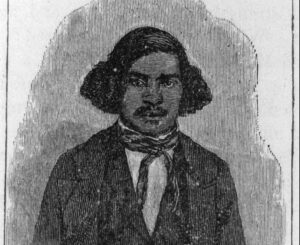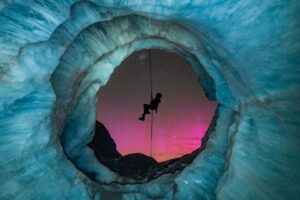A crew discovered lost film and cameras abandoned by the legendary photographer 85 years ago in the Yukon.
For historians, it’s like finding a treasure chest filled with gold.
This article was originally published on GearJunkie.
Teton Gravity Research, a media company, announced Thursday the discovery of a historic cache of camera equipment and mountain gear that belonged to Bradford Washburn and Robert Bates.
The pair of mountaineers left the gear while attempting to escape Canada’s remote Yukon wilderness in 1937. More than eight decades later, that gear has been found. The discovery elicited profound excitement from scientists, historians, and anyone who cares about the history of alpinism.

Glaciologist Dorota Medrzycka used glacial mapping to help find the lost gear. Photo: Teton Gravity Research
The searchers found the lost gear on the remote Walsh Glacier in Kluane National Park and Reserve.
“While there’s the obvious historical value in retrieving these artifacts, particularly the camera and film from one of the most legendary aerial photographers in history, the scientific value of the find is equally important, providing researchers with a data point to calculate glacier movements,” said expedition lead Griffin Post.

The lost aerial camera of Bradford Washburn. Photo: Teton Gravity Research
Lost gear from a historic photographer
Perhaps the most exciting item is “a significant portion” of Washburn’s Fairchild F-8 aerial camera, which the expedition successfully extracted from the ice.
Researchers believe it’s likely Washburn’s first-ever aerial photography camera. He gained worldwide notoriety for his aerial photos. Many such images are displayed at the Bradford Washburn American Mountaineering Museum in Golden, Colorado.
But there’s more than the camera. The expedition team also retrieved two motion-picture cameras: a DeVry “Lunchbox” model and a Bell & Howell Eyemo 71A. Both cameras still have film in them. Several pieces of mountaineering gear were recovered as well.
Post relied on glaciologist Dorota Medrzycka from the University of Ottawa to find the gear. A news release said that she leveraged “innovative glacial mapping processes” to determine where the cache may have moved over decades on the glacier.
After finding the cache, the team reported the find to Parks Canada. Working with Canadian officials and the Kluane First Nation, they retrieved everything a few weeks later.
“The rediscovery of the Washburn-Bates cache after 85 years locked in the ice adds a tangible dimension to an exciting story of exploration and survival at almost unbelievable odds,” said Sharon Thomson, an archaeologist for Parks Canada.
The discovery offers more than just historical artifacts — and hopefully salvageable photos. It may also lead to new insight into climate change.

The expedition found multiple cameras and alpine equipment lost for 85 years. Photo: Teton Gravity Research
A timeline of climate change
The discovery of the Washburn-Bates cache unlocks new data on glacial movements.
Available scientific data on glacial movement only dates back to the 1960s. With this finding, scientists might gain a new understanding of long-term changes to Walsh Glacier.
A Parks Canada team is treating the artifacts in labs in Ottawa and Winnipeg. The organization “looks forward to sharing these objects” and their stories with the public, the release said.
Curious to learn more? No worries, as one of the most prominent players in outdoor film, Teton Gravity Research documented everything from the expedition.
The outdoor media company plans to release a film about the discovery “in the near future”.






